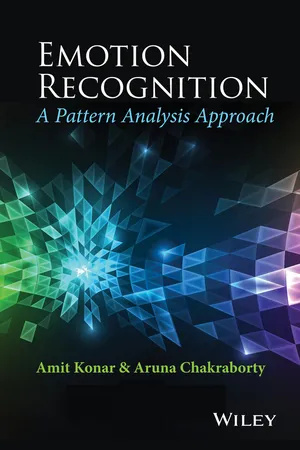
- English
- ePUB (mobile friendly)
- Available on iOS & Android
About This Book
A timely book containing foundations and current research directions on emotion recognition by facial expression, voice, gesture and biopotential signals This book provides a comprehensive examination of the research methodology of different modalities of emotion recognition. Key topics of discussion include facial expression, voice and biopotential signal-based emotion recognition. Special emphasis is given to feature selection, feature reduction, classifier design and multi-modal fusion to improve performance of emotion-classifiers. Written by several experts, the book includes several tools and techniques, including dynamic Bayesian networks, neural nets, hidden Markov model, rough sets, type-2 fuzzy sets, support vector machines and their applications in emotion recognition by different modalities. The book ends with a discussion on emotion recognition in automotive fields to determine stress and anger of the drivers, responsible for degradation of their performance and driving-ability. There is an increasing demand of emotion recognition in diverse fields, including psycho-therapy, bio-medicine and security in government, public and private agencies. The importance of emotion recognition has been given priority by industries including Hewlett Packard in the design and development of the next generation human-computer interface (HCI) systems. Emotion Recognition: A Pattern Analysis Approach would be of great interest to researchers, graduate students and practitioners, as the book
- Offers both foundations and advances on emotion recognition in a single volume
- Provides a thorough and insightful introduction to the subject by utilizing computational tools of diverse domains
- Inspires young researchers to prepare themselves for their own research
- Demonstrates direction of future research through new technologies, such as Microsoft Kinect, EEG systems etc.
Frequently asked questions
Information
1
INTRODUCTION TO EMOTION RECOGNITION
1.1 BASICS OF PATTERN RECOGNITION

1.2 EMOTION DETECTION AS A PATTERN RECOGNITION PROBLEM
1.3 FEATURE EXTRACTION
Table of contents
- Cover
- Title Page
- Copyright
- Dedication
- Preface
- Acknowledgments
- Contributors
- Chapter 1: Introduction to Emotion Recognition
- Chapter 2: Exploiting Dynamic Dependencies Among Action Units for Spontaneous Facial Action Recognition
- Chapter 3: Facial Expressions: A Cross-Cultural Study
- Chapter 4: A Subject-dependent Facial Expression Recognition System
- Chapter 5: Facial Expression Recognition Using Independent Component Features and Hidden Markov Model
- Chapter 6: Feature Selection for Facial Expression based on Rough Set Theory
- Chapter 7: Emotion Recognition from Facial Expressions Using Type-2 Fuzzy Sets
- Chapter 8: Emotion Recognition from Non-frontal Facial Images
- Chapter 9: Maximum a Posteriori based Fusion Method for Speech Emotion Recognition
- Chapter 10: Emotion Recognition in Naturalistic Speech and Language—A Survey
- Chapter 11: EEG-Based Emotion Recognition Using Advanced Signal Processing Techniques
- Chapter 12: Frequency Band Localization on Multiple Physiological Signals for Human Emotion Classification Using DWT
- Chapter 13: Toward Affective Brain–Computer Interface: Fundamentals and Analysis of EEG-based Emotion Classification
- Chapter 14: Bodily Expression for Automatic Affect Recognition
- Chapter 15: Building a Robust System for Multimodal Emotion Recognition
- Chapter 16: Semantic AudioVisual Data Fusion for Automatic Emotion Recognition
- Chapter 17: A Multilevel Fusion Approach for Audiovisual Emotion Recognition
- Chapter 18: From A Discrete Perspective of Emotions to Continuous, Dynamic, and Multimodal Affect Sensing
- Chapter 19: AudioVisual Emotion Recognition using Semi-Coupled Hidden Markov Model with State-Based Alignment Strategy
- Chapter 20: Emotion Recognition in Car Industry
- Index
- End User License Agreement